Hunter M. Claypatch, PhD
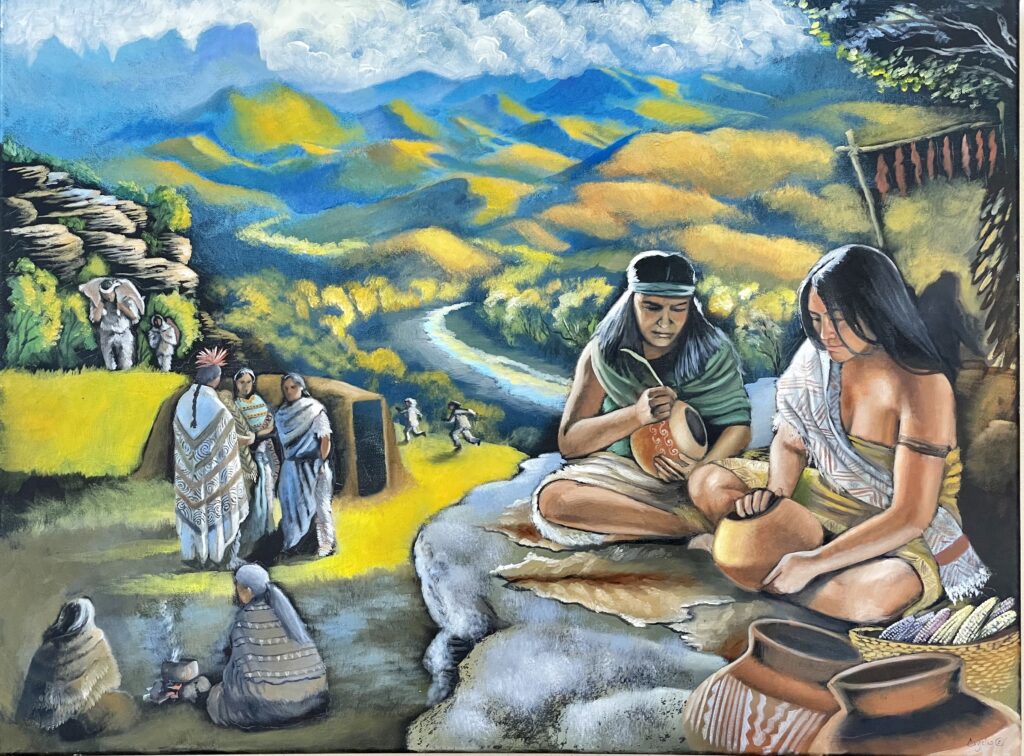
Miguel Grijalva (2024), Oil on Canvas
Key Concepts
- The Nogales Wash Site was primarily inhabited between 950 and 1150 CE (or AD), but there is evidence of earlier periodic occupation.
- The site is considered the southernmost Hohokam site, but also has extensive evidence of trade with the Trincheras tradition from northern Sonora.
- The site was formally excavated in 1982 and all artifacts from the site are housed at Pimeria Alta Historical Society.
- Community members are actively working to have the site placed on the National Registrar of Historic Places.
Key Terms
- Hohokam – The name for peoples who lived in southern Arizona between 450 to 1450 CE. The Hohokam constructed large irrigation canals, produced distinctive red-on-brown and red-on-buff pottery, and cremated their deceased.
- Trincheras – The name given to precolonial populations who lived in northern Sonora between ~400 to 1450 CE. The Trincheras are known for occupying terraced volcanic hills, producing purple-on-red pottery, and obtaining shell from the Sea of Cortez.
- Pithouse – The name used for semi-subterranean structures that people used to live in throughout the southwest United States and northern Mexico. Constructing houses partially underground allowed for individuals to keep cool in the summer and warm in the winter.
- Cremation Vessels – The name used for vessels which housed the cremated remains of an individual. This practice can be found throughout the world and was very common for Hohokam populations.
RESEARCH ARTICLE
B-1 Special Focus: What was the Ancient Border Community at the Nogales Wash Site?
Hunter M. Claypatch, PhD
Within the heart of Ambos Nogales is an important settlement that was used by local indigenous populations over a thousand years ago. The site, known as the Nogales Wash Site (AZ EE:09:93), has been known to researchers since the 1970s and is one of the few archaeological areas to be systematically excavated within Nogales. The Nogales Wash Site served as an important corridor for people, goods, and ideas from present-day Sonora to the Tucson Basin. It is also considered the southernmost known site to be inhabited by the ancient Hohokam. Our knowledge of the site continues expanding and tells a detailed story of how people lived in our border community over 1,000 years ago.
Initial Discovery
The Nogales Wash Site was first identified in 1978, after local resident Gabriel Ramírez found several ceramic vessels. Archaeologists rushed in to collect the exposed artifacts, but the site was soon forgotten. In 1982, the City of Nogales purchased the area for use as a landfill. After attempting to construct a road, evidence of a substantial precolonial settlement was uncovered.
In fall 1982, the Pimeria Alta Historical Society raised funds for archaeologist Felipe Jácome to excavate the site. Jácome’s excavation was a collaboration with the City of Nogales and the Nogales Unified School District. Students from Nogales High School assisted Jácome with the excavation and the analysis of artifacts from the site from 1982-1983. All materials recovered from the site are permanently curated at the Pimeria Alta Historical Society.


Archaeologist Felipe Jácome documented the Nogales Wash Site from 1982-1983 with the help Nogales High School students, making this (one of the southernmost known Hohokam settlements) even more unique from other Hohokam archaeological surveys. Jácome returned to the Nogales Wash Site in February 2024 with Nogales and Rio Rico High School students under the supervision of archaeologist Hunter Claypatch. Photos by Carlos F. Parra.
What Was the Nogales Wash Site?
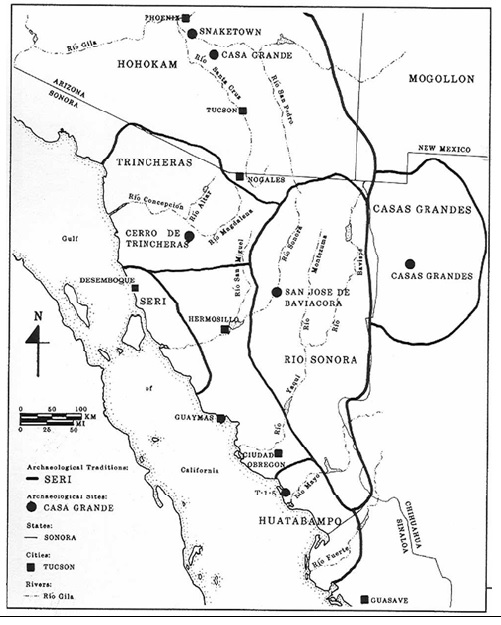
The Nogales Wash site receives its name from the nearby arroyo that it overlooks. For several centuries, the site served as a permanent settlement—a place where people lived, played, hunted, and were even buried.
The people who lived there are known as “Hohokam,” and archaeological evidence suggests that they most intensively occupied the site between 950 and 1150 CE. The Hohokam also lived in present-day Phoenix and Tucson and are known for their canal irrigation systems and extensive regional trade networks which reached into western Mexico. The Nogales Wash Site is significant for being one of the Hohokam’s southernmost known locations. The contemporary O’odham are descendants of the Hohokam.
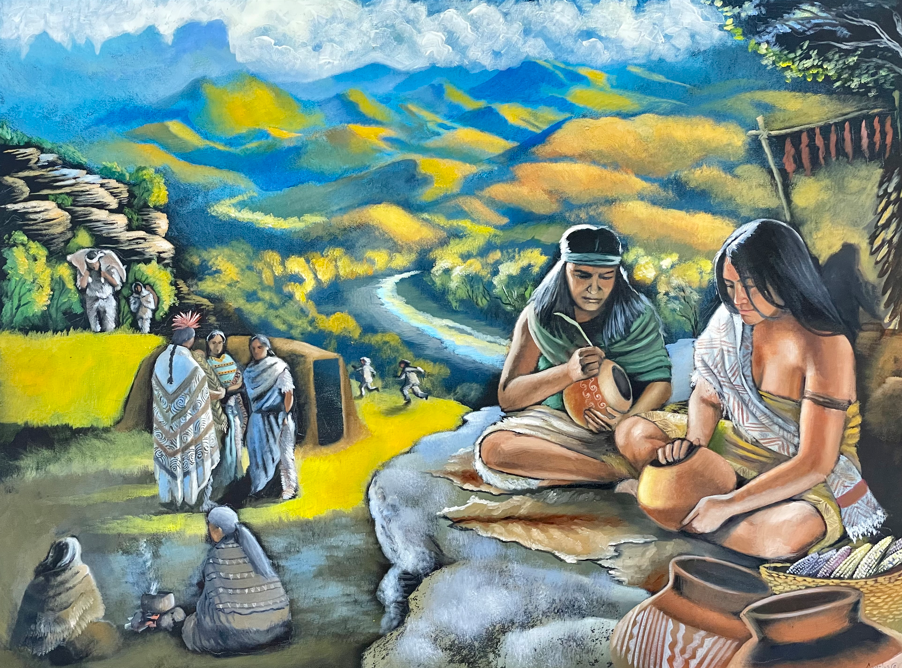
Ancient Borderlands: Our Indigenous Hohokam Heritage at the Nogales Wash Site
Miguel Grijalva (2024), Oil on Canvas
We know where people at the site lived because remains of houses were found during excavations. To keep cool in the summer and warm in the winter, the Hohokam built semi-subterranean pithouses and used wood beams that they dug into the floor to support a roof made with organic material. The houses themselves were small, about 25 feet by 16 feet, so much of their daily activity took place outside. Around 1100 CE, a communal platform was built in the middle of the site. The platform extended about 230 feet by 65 feet and was formed by collecting and compacting nearby dirt. Similar platforms have been found at other Hohokam sites and it may have been used as a space for ceremonies or gatherings.
Hunting, cooking, and agriculture at the site
The residents of Nogales Wash were sedentary agriculturalists. They grew domesticated corn and hunted local desert animals. Animal bones recovered from the site included turkey, jackrabbit, and deer. In comparison to other sites, there is a low level of animal remains and some believe that local populations consumed higher levels of domesticate crops. The remains of a dog were also found at the site. Throughout the Americas, dogs have long served as important guardians and companions.
Stone tool artifacts at the site served a variety of functions: including for hunting; hammering; cutting; and drilling. Various materials were utilized, such as quartz and rhyolite and chert and chalcedony, for producing fine stone tools. One of the most remarkable finds was a portion of a Paleoindian projectile point. This fragment is approximately 10,000 years old and was probably found by a traveling Hohokam who admired it and brought it back to the site.
Pottery is particularly important tool for understanding the Nogales Wash Site. Archaeologists have long recognized that ceramic styles frequently changed and that populations living in different regions produced slightly different ceramic styles. Pottery also tells us if vessels were used for storage, if they were regularly exposed to open flames, or if large vessels were produced for group gatherings.
Most of the pottery from the site was undecorated. Painted ceramics made up only 15% of the assemblage. Of the decorated pottery, the most frequent are painted with a red mineral pigment. These ceramics were either produced locally or originated from near Tucson. Pottery associated with the Trincheras tradition of northern Sonora was also commonly found at the site. Trincheras pottery can be differentiated from Hohokam ceramics based on its mineral purple-paint and distinctive designs.

Figure 1 Fragments of a decorated Trincheras tradition bowl from the Nogales Wash Site. This pottery style is called “Nogales Polychrome” because it utilizes red and purple paint on a cream-colored surface. Note how portions of this vessel are blackened—evidence of exposure to fire. This fragment is housed at the Pimeria Alta Historical Society.
Who did the Inhabitants of Nogales Wash Trade With?
Much like present-day Santa Cruz County is a center for trade and commerce, the Nogales Wash Site was in a prime location for trade with neighboring populations. The site is situated along the Nogales Wash, and near the Río Santa Cruz, and locals frequently traded for food, resources, and even ideas. Its inhabitants primarily traded with the Hohokam, who lived around modern-day Tucson, Arizona, and the Trincheras populations, who lived near Altar, Sonora.
Artifacts occasionally entered the site from even greater distances. Over 100 pottery fragments originated from near present-day Phoenix. Shell was also traded from communities along the Gulf of California. The vast majority of these are represented by fragments that had been shaped into bracelets. Other examples include a pendant and a drilled disk.

Burial Practices
The Nogales Wash site was not only an important place for daily life and activities, but individuals passed away and were buried at the site. Hohokam populations traditionally cremated their deceased and placed their remains in ceramic vessels. During the 1982-1983 excavations, the remains of twelve individuals were recovered from within cremation vessels. While these burials provide important information, Indigenous communities and archaeologists believe that they should be respected and returned to the ground. After a brief period, the remains were all reinterred at the site in a ceremony featuring members of the O’odham community.
Ongoing Research

Although the Nogales Wash Site was excavated over 40 years ago, we continue to learn more about these ancient local inhabitants. Dr. Hunter Claypatch of Pima Community College has reanalyzed thousands of pottery fragments from the site and determined that much of the pottery was locally produced. Four decades after the site’s last excavation, teenagers from Rio Rico and Nogales high school returned to the Nogales Wash Site through the “Archaeology of Ambos Nogales” program in 2024. With the help of Jácome and Claypatch, the high schoolers helped to document artifacts from within two 5×5 meter square units. These units were located to the east of the 1982 project area and in a portion of the site that was previously unrecorded.
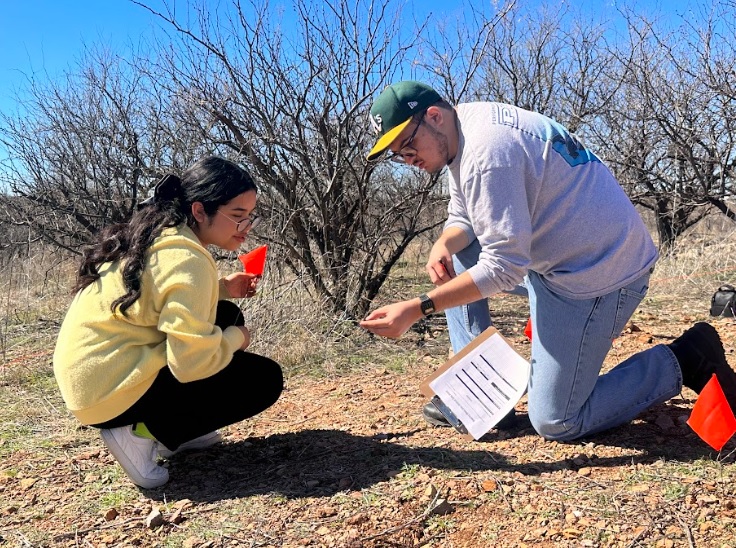
Young people were literally making history at this archaeological site! Along with other information, this data will be used to support efforts to add of the Nogales Wash Site to the National Register of Historic Places. The NRHPaims to preserve sites and structures of historical significance so that they can be seen and appreciated by future generations.
Conclusion
Over 1,000 years ago, the Nogales Wash Site served as one of Santa Cruz County’s most important precolonial settlements. The site laid buried and virtually unknown until excavations were undertaken in the early 1980s. These excavations demonstrated that the site was home to generations of Indigenous peoples called Hohokam. Archaeological evidence also revealed that these people regularly traded along the Río Santa Cruz with populations to the south, known as the Trincheras tradition. After over 40 years, archaeologists and local teenagers recently revisited the site and are working to have the site preserved through the National Register of Historic Places!
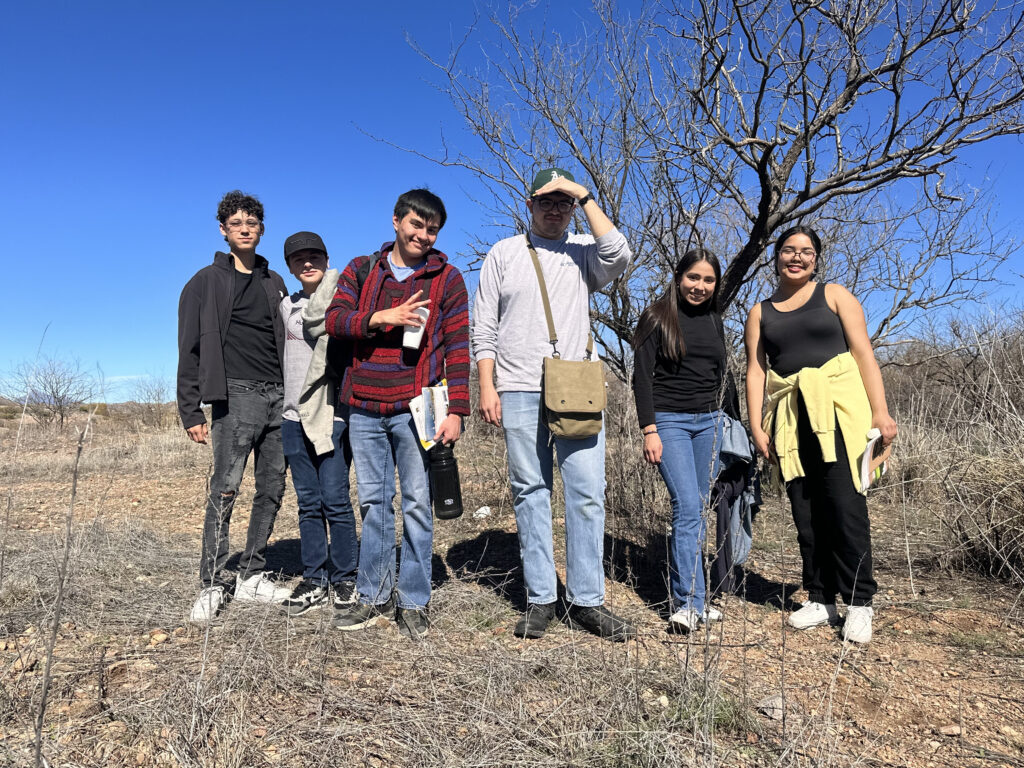
The Nogales Wash Site is an important part of the history of Ambos Nogales. If you visit the site, be sure not to remove any objects so that future generations can appreciate the site like you did.
About the Author
Hunter M. Claypatch, Ph.D., is an archaeologist who serves as a research associate at Binghamton University, an adjunct faculty member at Pima Community College, and a ceramic analyst for Desert Archaeology in Tucson, Arizona. He has participated in numerous binational collaborative projects in Sonora and Arizona. Claypatch is particularly interested in disseminating archaeological information across the U.S./Mexico border and ensuring that research is culturally relevant to local community members.
- Jácome, Felipe “The Nogales Wash Site” (1986)
- Who or What is Hohokam? Archaeology Southwest PDF
- “Hohokam: Shell Artisans” National Park Service PDF
- “Students document local history with archeology workshop” Daisy Zavala Magaña, Nogales International, February 2024: https://www.nogalesinternational.com/news/students-document-local-history-with-archeology-workshop/article_7426d074-cf6f-11ee-8778-3bf50768932c.html?fbclid=IwAR3HKz0yjleINTFK1IALnVMdH_oIN5UqMOGfI_TmqzvJgwu7l__tRYU2MI0_aem_Ac_0g3X_INyoNesK25WmW22QyEICrOEbRBoNYC0LYDens598Qk-wmvnfgW74CeXladdMy_aHFLEkdrEmeUKHxyhM
- Initial ASM Site Documentation PDF
- Stone tool blog: https://desert.com/hohokam-flake-tools/
